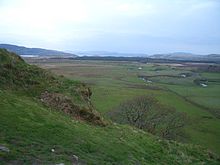Dalriada
Dalriada ( Old Irish : Dál Riata ) was a small kingdom of Celtic Scots that stretched between 300 and 800 across the north-east of Ireland , primarily the County of Antrim , and the mid-west of Scotland .
history
The Scots were originally located in the Irish province of Ulster , but then expanded their territory across the North Channel into County Argyll . The date of the first colonization of the Scottish part is uncertain. The "History of the Men of Scotland" (Senchus Fer nAlban), an Old Irish text from the 10th century, is based on material from the middle of the 7th century. "Fergus Mór mac Erc" and his dynasty came to Scotland around the beginning of the 6th century. His grandsons Comgall and Gabran, whose death has been recorded for about AD 550, occupied Cowal and Mid Argyll. The former even got its name from Comgall. This kingdom first flourished under Aidan Mac Gabhráin, who ruled from 574 to 608 AD. He built up a fleet and carried out raids to the Isle of Man and the Orkney , but lost a battle against the Anglo-Saxons at Daegsastan in 603 . In Ulster, too, Dalriada got on the defensive in the fight against the kings of the Uí Néill (Anglicised O'Neill ) (637 Battle of Mag Rath / Cath Maige Rátha ).
The seat of the early kings of Dalriada was probably the hill of Dunadd in the valley of the Add in ( Argyll and Bute ). The empire consisted of three subordinates ( kindred or cenél ): Gabráin, Loaime and Oengusa, to which the Comgall rule was added later. In Scotland, the Scottish Empire was opposed to the Anglo-Saxons of the Kingdom of Bernicia and the British of the Kingdom of Strathclyde in the south, especially the Picts in the north. The Picts subjugated the Scots Empire, but were quickly culturally adapted by the Scots. The kingdom was named Scotland after the Scots rather than the Picts . Its first king became Kenneth MacAlpin in 843 , who inherited Dalriada. The foundation of the monastery on Iona in 563 by Columba led to the first Christianization tendencies among the Picts.
Relationships
Trade relations
The evidence for jewelry production and the processing of precious metals show the prosperity, the wealth of knowledge and the far-reaching trade relations. Among the pottery found at Dunadd are imports from prehistoric sites in western Britain and continental centers. Class D pottery (D-ware), gray bowls made on a potter's wheel, have their origin on the Atlantic coast of France, probably near Bordeaux . Class E pottery ( E-ware ) includes glasses, mugs, bowls and jugs, the origin of which is probably also in Atlantic France and which was imported between the late 6th and 8th centuries. The reconstruction of Dunadd's e-goods is unique in Great Britain and is based on extensive excavations.
Political importance
The political importance of Dunadd is indicated by the structural character. RBK Stevenson, who dug in the 1950s, recognized defenses in his study that he called core forts. These include a relatively small citadel that was protected by a number of strong peripheral fortifications. Plants like Dunadd seem (at that time) to have achieved the status of local trading centers (like Gudme in Denmark shortly afterwards ); but it is unknown whether all places can be allocated to this period. There is also no clear separation between such places and the small walled duns with external works such as Dún Chonallaich and Dún na Maraig. Stevenson's interpretation of Dunadd and Dundurn met with criticism from Feschem and Alcock.
Reports from the 1980 excavation indicate (14C data) that the earliest part of Dunadd is the top oval fort, which was expanded to the southwest in a second phase. The earliest phase is at the transition from the 5th to the 6th and the second from the 6th to the 7th century. The final stage associated with Christison Plateau Fort probably dates from the 8th or 9th century. The editing of Dunadd's Ogham inscriptions by K. Forsyth did not bring clarity to the question of the interpretation of the text. A connection with the Pict attack on Dunadd in 736 AD cannot be established.
aftermath
The legacy of the Dálriada can be summed up from two perspectives:
- With the establishment of their rule in Scotland, they brought Old Irish to Scotland, although it should be noted that at that time the Picts belonged to a perhaps older, different language family. The language of the Scots developed during the Middle Ages to the Scottish Gaelic and Irish terms (such as Dun ) are more likely than found in the rest of the country in the West of Scotland.
- Since the Dálriada were largely able to assert themselves politically in the west and north of Scotland, they created (or restored) a cultural unity of Ireland and West Scotland, which can be traced back to the early 17th century.
Sources
The richest source of information are archaeological finds in Dunadd Fort (Siol nan Gaidheal). It has yielded artifacts from the 7th and 8th centuries that provide a better picture of contemporary culture and living conditions than is available for all earlier and some later periods in Scotland. The evidence for the somewhat contemporary but “Bruach an Druimein” is similarly good, but somewhat more limited. The richness of Dunadd's material is combined with the written sources and the ritual or totem character of the rock carvings found inside the fort and proves chronological relationships and the role of Dunadd.
literature
- The Royal Commission on the Ancient and historical Monuments of Scotland: Kilmartin Prehistoric and Early Historic Monuments. An Inventory of the Monuments Extracted from "Argyll, Volume 6" . The Royal Commission on the Ancient and historical Monuments of Scotland (RCAHMS), Edinburgh 2008, ISBN 978-1-902419-03-9 .
- Alan Lane, Ewan Campbell: Dunadd. To early Dalriadic capital. Oxbow Books, Oxford 2000, ISBN 1-84217-024-4 .

